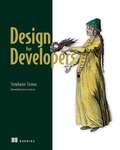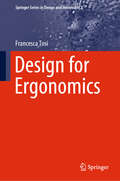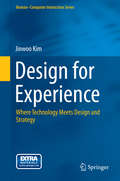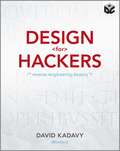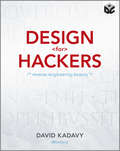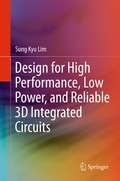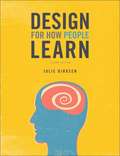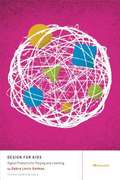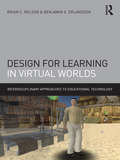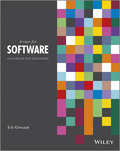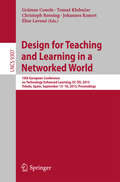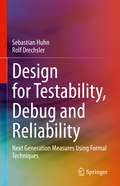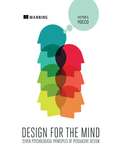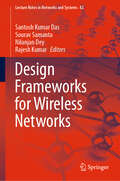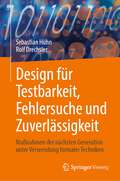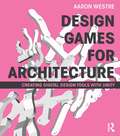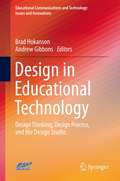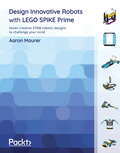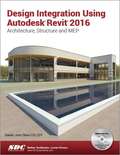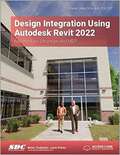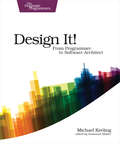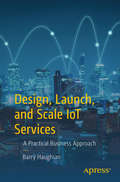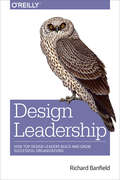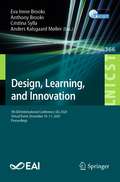- Table View
- List View
Design for Developers
by Stephanie StimacSolve common application design and usability issues with flair! These essential design and UX techniques will help you create good user experiences, iterate smoothly on frontend features, and collaborate effectively with designer colleagues.In Design for Developers you will learn how to: Use color, typography, and layout to create hierarchy on a web page Apply color palettes consistently in a user interface Choose the correct typefaces and fonts Conduct user research to validate design decisions Quickly plan a website&’s layout and structure In Design for Developers, author Stephanie Stimac shares the unique insights she&’s learned as a designer on the Microsoft Developer Experiences team. This one-of-a-kind book provides a developer-centric approach to the essential design fundamentals of modern web applications. You&’ll learn how to craft a polished visual design with just color, space, and typeface, and put all your new skills into practice to design a website from scratch. Foreword by Aaron Gustafson. About the technology Developer-made design decisions can have a real impact on a site&’s user experience. Learn to speak design&’s language, and you&’ll be able to confidently contribute to a design process, collaborate with designer colleagues, and make more informed decisions about how you build your apps. About the book Design for Developers reveals essential design and UX principles every web developer needs to know. You&’ll love the book&’s developer-centric approach, which demonstrates new ideas with examples from popular sites and user interfaces. Discover insightful techniques for user research, and learn to use color, typography, and layout to create communicative web visuals. By the time you&’re done reading, you&’ll know it&’s true: having good design sense will make you a better web developer! What's inside Conduct user research to validate design decisions Quickly plan a website&’s layout and structure Iterate smoothly on frontend features Use color, typography, and layout to create hierarchy on a web page About the reader For web developers familiar with HTML, CSS, and the JavaScript basics. About the author Stephanie Stimac is a design technologist and senior product manager who focuses on building and improving developer experiences. She has previously worked on the Microsoft Edge browser. Table of Contents PART 1 DESIGN BASICS 1 Bridging the gap between design and development 2 Design fundamentals PART 2 USER EXPERIENCE 3 User experience basics 4 User research 5 User experience design PART 3 VISUAL DESIGN ELEMENTS 6 Web layout and composition 7 Enhancing web layout with animation 8 Choosing and working with typography on the web 9 Color theory 10 Building a website PART 4 AFTER VISUAL DESIGN 11 Test, validate, iterate 12 Developer choices and user experience
Design for Ergonomics (Springer Series in Design and Innovation #2)
by Francesca TosiThis book focuses on the global quality of the design of systems that people interact with during their work activities and daily lives; a quality that involves the globality of people’s experience – physical, sensory, cognitive and emotional. It presents a concise and structured overview of the ergonomic approach to planning, and of methodological and operational tools from ergonomic research that can more directly and concretely contribute to the design process. The book also explores physical ergonomics and cognitive ergonomics, which are essential components of design culture. The final section addresses the main design problems and intervention criteria regarding the design of environments, products and equipment, as well as the design of communication, training and learning interface systems based on digital technologies. The book is chiefly intended for designers and anyone interested in the methods, tools and opportunities for in-depth analysis and development that ergonomics can offer regarding the conception, production and testing of products, environments and services, whether physical or virtual. It also offers a learning resource for professionals and students in Industrial Design and Planning.
Design for Experience
by Jinwoo KimPresents a strategic perspective and design methodology that guide the process of developing digital products and services that provide 'real experience' to users. Only when the material experienced runs its course to fulfilment is it then regarded as 'real experience' that is distinctively senseful, evaluated as valuable, and harmoniously related to others. Based on the theoretical background of human experience, the book focuses on these three questions: How can we understand the current dominant designs of digital products and services? What are the user experience factors that are critical to provide the real experience? What are the important HCI design elements that can effectively support the various UX factors that are critical to real experience? Design for Experience is intended for people who are interested in the experiences behind the way we use our products and services, for example designers and students interested in interaction, visual graphics and information design or practitioners and entrepreneurs in pursuit of new products or service-based start-ups.
Design for Hackers: Reverse Engineering Beauty
by David KadavyMany design books try to teach design through lists of "do's" and "don'ts." But hackers know you need a deeper understanding of something to really do it well. Design for Hackers takes apart design by "reverse-engineering" Impressionist painting, Renaissance sculpture, the Mac OS X Aqua interface, Twitter's web interface, and much more. You'll learn about color theory, typography, proportions, and design principles. This theoretical advice is mixed with concrete, actionable advice such as suggestions for color scheme tools, and a chart of "all of the fonts you'll ever need".
Design for Hackers: Reverse Engineering Beauty
by David KadavyDiscover the techniques behind beautiful design by deconstructing designs to understand them The term 'hacker' has been redefined to consist of anyone who has an insatiable curiosity as to how things work—and how they can try to make them better. This book is aimed at hackers of all skill levels and explains the classical principles and techniques behind beautiful designs by deconstructing those designs in order to understand what makes them so remarkable. Author and designer David Kadavy provides you with the framework for understanding good design and places a special emphasis on interactive mediums. You'll explore color theory, the role of proportion and geometry in design, and the relationship between medium and form. Packed with unique reverse engineering design examples, this book inspires and encourages you to discover and create new beauty in a variety of formats. Breaks down and studies the classical principles and techniques behind the creation of beautiful design Illustrates cultural and contextual considerations in communicating to a specific audience Discusses why design is important, the purpose of design, the various constraints of design, and how today's fonts are designed with the screen in mind Dissects the elements of color, size, scale, proportion, medium, and form Features a unique range of examples, including the graffiti in the ancient city of Pompeii, the lack of the color black in Monet's art, the style and sleekness of the iPhone, and more By the end of this book, you'll be able to apply the featured design principles to your own web designs, mobile apps, or other digital work.
Design for High Performance, Low Power, and Reliable 3D Integrated Circuits
by Sung Kyu LimThis book provides readers with a variety of algorithms and software tools, dedicated to the physical design of through-silicon-via (TSV) based, three-dimensional integrated circuits. It describes numerous "manufacturing-ready" GDSII-level layouts of TSV-based 3D ICs developed with the tools covered in the book. This book will also feature sign-off level analysis of timing, power, signal integrity, and thermal analysis for 3D IC designs. Full details of the related algorithms will be provided so that the readers will be able not only to grasp the core mechanics of the physical design tools, but also to be able to reproduce and improve upon the results themselves. This book will also offer various design-for-manufacturability (DFM), design-for-reliability (DFR), and design-for-testability (DFT) techniques that are considered critical to the physical design process.
Design For How People Learn (Voices That Matter)
by Julie DirksenIn this book, you will discover how to use the key principles behind learning, memory, and attention to create materials that enable your audience to both gain and retain the knowledge and skills you're sharing. Updated to cover new insights and research into how we learn and remember, this new edition includes new techniques for using social media for learning as well as two brand new chapters on designing for habit and best practices for evaluating learning, such as how and when to use tests. Using accessible visual metaphors and concrete methods and examples, this book will teach you how to leverage the fundamental concepts of instructional design both to improve your own learning and to engage your audience.
Design For Kids
by Debra Levin GelmanEmotion. Ego. Impatience. Stubbornness. Characteristics like these make creating sites and apps for kids a daunting proposition. However, with a bit of knowledge, you can design experiences that help children think, play, and learn. With Design for Kids, you'll learn how to create digital products for today's connected generation.
Design for Learning in Virtual Worlds (Interdisciplinary Approaches to Educational Technology)
by Benjamin E. Erlandson Brian C. NelsonDesign for Learning in Virtual Worlds, the first book focused specifically on how to design virtual worlds for educational purposes, explores: * the history and evolution of virtual worlds * the theories behind the use of virtual worlds for learning * the design of curricula in virtual worlds * design guidelines for elements experienced in virtual worlds that support learning * design guidelines for learning quests and activities in virtual worlds. The authors also examine the theories and associated design principles used to create embedded assessments in virtual worlds. Finally, a framework and methodology is provided to assist professionals in evaluating "off-the-shelf" virtual worlds for use in educational and training settings. Design for Learning in Virtual Worlds will be invaluable both as a professional resource and as a textbook for courses within Educational Technology, Learning Sciences, and Library Media programs that focus on gaming or online learning environments.
Design for Software
by Erik KlimczakA unique resource to help software developers create a desirable user experience Today, top-flight software must feature a desirable user experience. This one-of-a-kind book creates a design process specifically for software, making it easy for developers who lack design background to create that compelling user experience. Appealing to both tech-savvy designers and creative-minded technologists, it establishes a hybrid discipline that will produce first-rate software. Illustrated in full color, it shows how to plan and visualize the design to create software that works on every level. Today's software demands attention to the quality of the user experience; this book guides you through a practical design process to achieve that goal Approaches the mechanics of design with a process inspired by art and science Avoids the abstract and moves step by step through techniques you can put to use immediately Covers planning your design, tested methods, how to visualize like a designer, psychology of design, and how to create software that developers will appreciate Explores such elements as choosing the right typeface and managing interactivity Design for Software: A Playbook for Developers brings the art of good design together with the science of software development to create programs with pizazz.
Design for Teaching and Learning in a Networked World: 10th European Conference on Technology Enhanced Learning, EC-TEL 2015, Toledo, Spain, September 15-18, 2015, Proceedings (Lecture Notes in Computer Science #9307)
by Gráinne Conole Tomaž Klobučar Christoph Rensing Johannes Konert Élise LavouéThis book constitutes the refereed proceedings of the 10th European Conference on Technology Enhanced Learning, EC-TEL 2015, held in Toledo, Spain, in September 2015. The 27 full papers, 19 short papers, 9 demo papers and 23 posters were carefully reviewed and selected from 176 submissions. They address topics such as blended learning; self-regulated and self directed learning; reflective learning; intelligent learning systems; learning communities; learning design; learning analytics; learning assessment; personalization and adaptation; serious games; social media; massive open online courses (MOOCs); schools of the future.
Design for Testability, Debug and Reliability: Next Generation Measures Using Formal Techniques
by Sebastian Huhn Rolf DrechslerThis book introduces several novel approaches to pave the way for the next generation of integrated circuits, which can be successfully and reliably integrated, even in safety-critical applications. The authors describe new measures to address the rising challenges in the field of design for testability, debug, and reliability, as strictly required for state-of-the-art circuit designs. In particular, this book combines formal techniques, such as the Satisfiability (SAT) problem and the Bounded Model Checking (BMC), to address the arising challenges concerning the increase in test data volume, as well as test application time and the required reliability. All methods are discussed in detail and evaluated extensively, while considering industry-relevant benchmark candidates. All measures have been integrated into a common framework, which implements standardized software/hardware interfaces.
Design for the Mind: Seven Psychological Principles of Persuasive Design
by Victor YoccoSummaryDesign for the Mind: Seven Psychological Principles of Persuasive Design teaches web designers and developers how to create sites and applications that appeal to our innate natural responses as humans. Author Victor Yocco, a researcher on psychology and communication, introduces the most immediately relevant and applicable psychological concepts, breaks down each theory into easily-digested principles, then shows how they can be used to inform better design.Purchase of the print book includes a free eBook in PDF, Kindle, and ePub formats from Manning Publications.About the TechnologyDesigners and design team members need to think about more than just aesthetics. How do you handle short attention spans. How does your design encourage users to engage, browse, or buy? Fortunately, there are psychological principles that you can use in your design to anticipate and benefit from how humans think, behave, and react.About the BookDesign for the Mind: Seven Psychological Principles of Persuasive Design teaches you to recognize how websites and applications can benefit from an awareness of our innate, natural responses as humans, and to apply the same principles to your own designs. This approachable book introduces the psychological principles, deconstructs each into easily digestible concepts, and then shows how you can apply them. The idea is to deepen your understanding of why people react in the ways they do. After reading the book, you'll be ready to make your work more psychologically friendly, engaging, and persuasive.What's InsideMaking design persuasiveEncouraging visitors to take actionCreating enduring messagesMeeting the needs of both engaged and disengaged visitorsBecoming a strategic influencerApplying theory, with case studies and real-world examplesAbout the ReaderThis book is for web and UX designers and developers as well as anyone involved in customer-facing digital products.About the AuthorVictor Yocco, PhD, is a research director at a Philadelphia-based digital design firm. He received his PhD from The Ohio State University, where his research focused on psychology and communication in informal learning settings. Victor regularly writes and speaks on topics related to the application of psychology to design and addressing the culture of alcohol use in design and technology. He can be found at www.victoryocco.com or @victoryocco on Twitter.Table of ContentsPART 1 INTRODUCING THE APPLICATION OF PSYCHOLOGY TO DESIGNMeeting users' needs: including psychology in designPART 2 WHY DO FOLKS ACT LIKE THAT? PRINCIPLES OF BEHAVIORDesigning for regular use: addressing planned behaviorRisky decisions and mental shortcutsMotivation, ability, and trigger-boom!PART 3 PRINCIPLES OF INFLUENCE AND PERSUASION: NOT AS EVIL AS YOU'D THINKInfluence: getting people to like and use your designUsing family, friends, and social networks to influence usersIt's not what you say; it's how you say it!Persuasion: the deadliest artPART 4 USER EXPERIENCE DESIGN: PUTTING IT ALL TOGETHERCase study: KidTech Design Co.'s Good Choice appThe next step: getting up and running
Design Frameworks for Wireless Networks (Lecture Notes in Networks and Systems #82)
by Santosh Kumar Das Sourav Samanta Nilanjan Dey Rajesh KumarThis book provides an overview of the current state of the art in wireless networks around the globe, focusing on utilizing the latest artificial intelligence and soft computing techniques to provide design frameworks for wireless networks. These techniques play a vital role in developing a more robust algorithm suitable for the dynamic and heterogeneous environment, making the network self-managed, self-operational, and self-configurational, and efficiently reducing uncertainties and imprecise information.
Design für Testbarkeit, Fehlersuche und Zuverlässigkeit: Maßnahmen der nächsten Generation unter Verwendung formaler Techniken
by Sebastian Huhn Rolf DrechslerIn diesem Buch werden mehrere neue Ansätze vorgestellt, die den Weg für die nächste Generation integrierter Schaltungen ebnen, die auch in sicherheitskritischen Anwendungen erfolgreich und zuverlässig integriert werden können. Die Autoren beschreiben neue Maßnahmen zur Bewältigung der steigenden Herausforderungen im Bereich des Designs für Testbarkeit, Fehlersuche und Zuverlässigkeit, die für moderne Schaltungsentwürfe unbedingt erforderlich sind. Insbesondere werden in diesem Buch formale Techniken wie das Satisfiability (SAT)-Problem und das Bounded Model Checking (BMC) kombiniert, um die entstehenden Herausforderungen in Bezug auf die Zunahme des Testdatenvolumens, die Testanwendungszeit und die erforderliche Zuverlässigkeit zu bewältigen. Alle Methoden werden detailliert diskutiert und unter Berücksichtigung von industrie-relevanten Benchmark-Kandidaten ausführlich evaluiert. Alle Maßnahmen wurden in ein gemeinsames Framework integriert, das standardisierte Software/Hardware-Schnittstellen implementiert.
Design Games for Architecture: Creating Digital Design Tools with Unity
by Aaron WestreDesign Games for Architecture teaches you how to create playful software tools based on your architectural design processes, whether or not you are familiar with game design technology. The book combines the fun and engaging aspects of video games to ease the sometimes complex process of learning software development. By working through exercises illustrated with screen shots and code, you acquire knowledge about each step required to build useful tools you can use to accomplish design tasks. Steps include analysing design processes to identify their logic, translating that logic into a collection of objects and functions, then encoding the design procedure into a working software tool. Examples presented in the book are design games---tools that a designer “plays” like video games---that span a wide range of design activities. These software tools are built using Unity, free, innovative, and industry-leading software for video game development. Unity speeds up the process of software creation, offers an interface that will be familiar to you, and includes very advanced tools for creating forms, effects, and interactivity. If you are looking to add cutting-edge skills to your repertoire, then Design Games will help you sharpen your design thinking and allow you to specialize in this new territory while you learn more about your own design processes.
Design in Educational Technology: Design Thinking, Design Process, and the Design Studio
by Brad Hokanson Andrew GibbonsThis book is the result of a research symposium sponsored by the Association for Educational Communications and Technology [AECT]. The fifteen chapters were developed by leaders in the field and represent the most updated and cutting edge methodology in the areas of instructional design and instructional technology. The broad concepts of design, design thinking, the design process, and the design studio, are identified and they form the framework of the book. This book advocates the conscious adoption of a mindset of design thinking, such as that evident in a range of divergent professions including business, government, and medicine. At its core is a focus on "planning, inventing, making, and doing." (Cross, 1982), all of which are of value to the field of educational technology. Additionally, the book endeavors to develop a deep understanding of the design process in the reader. It is a critical skill, often drawing from other traditional design fields. An examination of the design process as practiced, of new models for design, and of ways to connect theory to the development of educational products are all fully explored with the goal of providing guidance for emerging instructional designers and deepening the practice of more advanced practitioners. Finally, as a large number of leading schools of instructional design have adopted the studio form of education for their professional programs, we include this emerging topic in the book as a practical and focused guide for readers at all levels.
Design Innovative Robots with LEGO SPIKE Prime: Seven creative STEM robotic designs to challenge your mind
by Aaron MaurerDiscover how to use the LEGO SPIKE Prime kit and boost your confidence in robotics, coding, and engineeringKey FeaturesGet up and running with new parts not seen in previous LEGO kitsGain deeper insights into non-compatible sensors and components that work with all prior LEGO components and third-party elementsExplore new features and experiment with new robot builds with LEGO's new coding platformBook DescriptionThe new LEGO SPIKE Prime is one of the latest additions to the LEGO robotics line of products. This book will help you to enjoy building robots and understand how exciting robotics can be in terms of design, coding, and the expression of ideas. The book begins by taking you through a new realm of playful learning experiences designed for inventors and creators of any age. In each chapter, you'll find out how to build a creative robot, learn to bring the robot to life through code, and finally work with exercises to test what you've learned and remix the robot to suit your own unique style. Throughout the chapters, you'll build exciting new smart robots such as a handheld game, a robotic arm with a joystick, a guitar, a flying bird, a sumobot, a dragster, and a Simon Says game. By the end of this LEGO book, you'll have gained the knowledge and skills you need to build any robot that you can imagine.What you will learnDiscover how the LEGO SPIKE Prime kit works, and explore its parts and the elements inside themBuild and design robots that go beyond basic robotic designsCreate interactive robots with the help of sensorsExplore real-world robots and learn how to build them by yourselfFind out challenging ways to remix build ideas with your own imagination and skillsDevelop coding skills using the Scratch programming interfaceWho this book is forThis book is for robot enthusiasts, LEGO lovers, hobbyists, educators, students, and anyone looking to learn about the new LEGO SPIKE Prime kit. The book is designed to go beyond the basic builds to intermediate and advanced builds, while also helping you to learn how to add your own personal touch to the builds and code. To make the most of this book, you'll need a basic understanding of build techniques, coding in block-based software environments, and weaving them together to create unique robot builds.
Design Integration Using Autodesk Revit 2016
by Daniel John StineDesign Integration Using Autodesk Revit 2016
Design Integration Using Autodesk Revit 2022
by Daniel John StineDesign Integration Using Autodesk Revit 2022 is designed to provide you with a well-rounded knowledge of Autodesk Revit tools and techniques. <p><p>All three disciplines of the Revit platform are introduced in this textbook. This approach gives you a broad overview of the Building Information Modeling (BIM) process. The topics cover the design integration of most of the building disciplines: Architectural, Interior Design, Structural, Mechanical, Plumbing and Electrical. Civil is not covered, but adding topography to your model is. Each book also includes access to nearly 100 video tutorials designed to further help you master Autodesk Revit. <p><p> Throughout the book you develop a two story law office. The drawings start with the floor plans and develop all the way to photo-realistic renderings similar to the one on the cover of this book. Along the way the building’s structure, ductwork, plumbing and electrical (power and lighting) are modeled. By the end, you will have a thorough knowledge of many of the Revit basics needed to be productive in a classroom or office environment. Even if you will only be working with one component of Revit in your chosen profession, this book will give you important knowledge on how the other disciplines will be doing their work and valuable insight into the overall process. <p><p> The first four chapters cover many of the Revit basics needed to successfully and efficiently work with the software. Once the fundamentals are covered, the remaining chapters walk you through a building project which is started from scratch so nothing is taken for granted by you or the author.
Design Is The Problem
by Nathan ShedroffDesign makes a tremendous impact on the produced world in terms of usability, resources, understanding, and priorities. What we produce, how we serve customers and other stakeholders, and even how we understand how the world works is all affected by the design of models and solutions. Designers have an unprecedented opportunity to use their skills to make meaningful, sustainable change in the world--if they know how to focus their skills, time, and agendas. In Design is the Problem: The Future of Design Must be Sustainable, Nathan Shedroff examines how the endemic culture of design often creates unsustainable solutions, and shows how designers can bake sustainability into their design processes in order to produce more sustainable solutions.
Design It!: From Programmer to Software Architect
by Michael KeelingDon't engineer by coincidence-design it like you mean it! Filled with practical techniques, Design It! is the perfect introduction to software architecture for programmers who are ready to grow their design skills. Lead your team as a software architect, ask the right stakeholders the right questions, explore design options, and help your team implement a system that promotes the right -ilities. Share your design decisions, facilitate collaborative design workshops that are fast, effective, and fun-and develop more awesome software!With dozens of design methods, examples, and practical know-how, Design It! shows you how to become a software architect. Walk through the core concepts every architect must know, discover how to apply them, and learn a variety of skills that will make you a better programmer, leader, and designer. Uncover the big ideas behind software architecture and gain confidence working on projects big and small. Plan, design, implement, and evaluate software architectures and collaborate with your team, stakeholders, and other architects. Identify the right stakeholders and understand their needs, dig for architecturally significant requirements, write amazing quality attribute scenarios, and make confident decisions. Choose technologies based on their architectural impact, facilitate architecture-centric design workshops, and evaluate architectures using lightweight, effective methods. Write lean architecture descriptions people love to read. Run an architecture design studio, implement the architecture you've designed, and grow your team's architectural knowledge. Good design requires good communication. Talk about your software architecture with stakeholders using whiteboards, documents, and code, and apply architecture-focused design methods in your day-to-day practice. Hands-on exercises, real-world scenarios, and practical team-based decision-making tools will get everyone on board and give you the experience you need to become a confident software architect.
Design, Launch, and Scale IoT Services: A Practical Business Approach
by Barry HaughianThe Internet of Things is causing major industry disruption, so companies need to plan and manage their “IoT journey” to maximize all business opportunities. In this book companies can learn how to successfully create, launch and manage Internet of Things services. It takes the reader through the process of specifying, implementing, and deploying IoT services; detailing how to scale and manage an IoT business. It introduces the fundamentals of IoT services, explaining IoT service building blocks and the key factors to be considered in the design of IoT services. Moving into the IoT field requires speed. This book provides a fast track approach to IoT; summarizing the global experiences of the author, detailing the discussions, mistakes, successes, learnings and conclusions. Building an Internet of Things Service enables readers to accelerate their own on-boarding in their IoT journey.What You'll LearnCreate new IoT ServicesReview the basic IoT concepts and business implications you need to know as you embark on your IoT journeySolve the major challenges presented by the IoT disruption.Accelerate your own on-boarding in their IoT journey.Who This Book Is ForThe primary audience is made up of business executives and IoT startups. The secondary audience is students studying IoT in universities and those interested in understanding the fundamentals of an IoT business. No technical background is required.
Design Leadership
by Richard BanfieldWhat does it take to be the leader of a design firm or group? We often assume they have all the answers, but in this rapidly evolving industry they're forced to find their way like the rest of us. So how do good design leaders manage? If you lead a design group, or want to understand the people who do, this insightful book explores behind-the-scenes strategies and tactics from leaders of top design companies throughout North America.Based on scores of interviews he conducted over a two-year period--from small companies to massive corporations like ESPN--author Richard Banfield covers a wide range of topics, including:How design leaders create a healthy company cultureInnovative ways for attracting and nurturing talentCreating productive workspaces, and handling remote employeesStaying on top of demands while making time for themselvesConsistent patterns among vastly different leadership stylesTechniques and approaches for keeping the work pipeline fullMaking strategic and tactical plans for the futureMistakes that design leaders made--and how they bounced back
Design, Learning, and Innovation: 5th EAI International Conference, DLI 2020, Virtual Event, December 10-11, 2020, Proceedings (Lecture Notes of the Institute for Computer Sciences, Social Informatics and Telecommunications Engineering #366)
by Eva Irene Brooks Anthony Brooks Cristina Sylla Anders Kalsgaard MøllerThis book constitutes the refereed post-conference proceedings the 5th EAI International Conference on DLI 2020, Design, Leaning and Innovation, which took place in December 2020. Due to COVID-19 pandemic the conference was held virtually. The 14 revised full papers presented were carefully selected from 40 submissions and are organized in four thematic sessions on: digital technologies and learning; designing for innovation; digital games, gamification and robots; designs for innovative learning.
